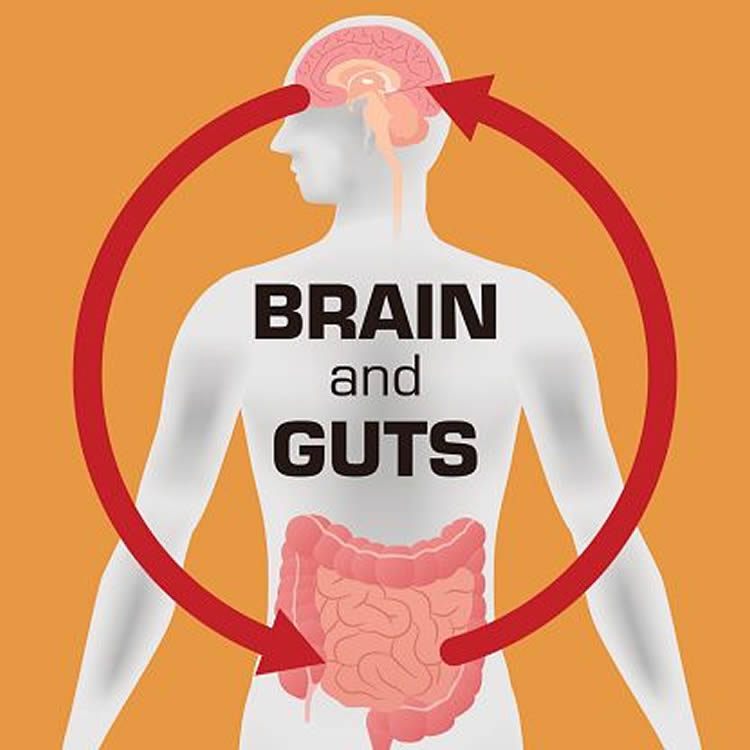Of Guts and Brain: The Gut-Brain Axis

As a body-mind practitioner, I have become increasingly interested in the complex interplay between the gut (the enteric nervous system) and the brain (the central and autonomic nervous systems). The communication between these nervous systems occurs primarily through neural, endocrine, immune and humoral links (Carabotti, 2015).
Compelling evidence of a gastrointestinal microbe-brain interaction was observed over twenty years ago, when treatment with oral antibiotics brought about a dramatic improvement in patients with hepatic encephalopathy. Although much research has been done via animal models (Carabotti et al., 2015), apparently many of these researchers do not attempt to extend their findings to humans. Nevertheless significant links have emerged since the 90s between the microbiome (the internal habitat of flora) and conditions such as anxiety, depression, the autistic spectrum, neurodegenerative disease such as Alzheimer’s and Parkinson’s (among others), attention deficit disorder and ADHD (Perlmutter, 2015).
Carabotti et al., (2015) review animal studies which document that gut microbiota interact with the CNS by regulating brain chemistry and influencing neuro-endocrine systems associated with the stress response, as well as anxiety and memory functions. These bidirectional mechanisms of communication between the gut and the brain continue to be elucidated by researchers examining neuroendocrine and metabolic pathways, and involved in the mapping of both afferent and efferent links between the cognitive and emotional centers of the brain (e.g., hippocampus, amygdala) and peripheral intestinal functions.
According to neurologist David Perlmutter (2015), the microbiome is affected by probiotics and antibiotics, stress (e.g., cortisol), environmental toxins, and the food we partake (e.g., gluten and sugar). Among other things, these variables affect the production of local neurotransmitters in the gut, including serotonin, melatonin, and GABA.
The state of our microbiome affects the activity and function of the endocrine system (the hypothalamic–pituitary–adrenal (HPA) axis), the immune system, the hormonal system, and aspects of mental health, including cognition, affect, mood, memory, and the ability to learn. The modulation of the brain-derived growth factor, BDNP, which accounts for the neuroplasticity of the brain, that is, its ability to grow and change during the lifespan, is also affected.
According to Perlmutter (2015), the two-way street of communication is adversely affected by inflammation.
Since both Hyman (2012) and Perlmutter (2015) argue that we are what we eat, both medics favor a gluten-and sugar-free diet and are proponents of low carb, high (omega 3) fat regimens. Based on available statistics, Hyman (2012) believes that for those of us who are not already diabetic, chances are we will be. He has coined the term diabesity to capture the continuum between obesity and diabetes. In his book, The Blood-Sugar Solution, he proposes a rigorous six-week program designed to reset and reboot the body’s metabolism, especially if coupled with a course of probiotics that changes the ratio between “good” and “bad” bacteria. This regimen involves avoiding not only gluten and sugar, but also dairy, coffee, alcohol, and fruit (with the exception of berries, which are low glycemic). Hyman cautions that diabetics should follow his program under the guidance of their physician, since it may lower blood sugar considerably. Coupled with a good night’s sleep, plenty of physical activity, less stress, and to the extent possible, less exposure to environmental toxins (see Perlmutter, 2015), the blood-sugar solution should definitely promote health. According to Hyman, a proponent of functional medicine, which seeks to treat the core underlying causes rather than symptoms of disease, “Disease goes away as a side effect of health.” (2012, p. 29).
Probiotics, diet, and lifestyle may all help eradicate disease.
References
Carabotti, M. et al. (2015). The gut-brain axis: interactions between enteric microbiota, central and enteric nervous systems. Ann. Gastroenterol. 2015 Apr-Jun 28(2): 203-209
Hyman, M. (2012). The Blood-Sugar Solution. New York: Little Brown and Company.
Perlmutter, D. (2015). Brain Maker. The Power of Gut Microbes to Heal and Protect Your Brain For Life. London: Yellow Kite Books.



